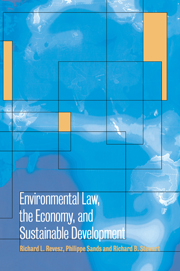 Environmental Law, the Economy and Sustainable Development
Environmental Law, the Economy and Sustainable Development Book contents
- Frontmatter
- Contents
- List of contributors
- Introduction: environmental regulation in multi-jurisdictional regimes
- PART I ENVIRONMENTAL REGULATION IN FEDERAL SYSTEMS
- PART II ENVIRONMENTAL REGULATION AND INTERNATIONAL TRADE
- PART III CHOICE OF ENVIRONMENTAL POLICY INSTRUMENTS
- 7 Economic incentives for environmental protection: opportunities and obstacles
- 8 Market-based incentives for environmental protection
- 9 Equity and efficiency in global emissions markets
- PART IV THE ENVIRONMENTAL STANDARD - SETTING PROCESS
- PART V INTERNATIONAL ENVIRONMENTAL LAW AND SUSTAINABLE DEVELOPMENT
- Index
8 - Market-based incentives for environmental protection
Published online by Cambridge University Press: 03 May 2010
- Frontmatter
- Contents
- List of contributors
- Introduction: environmental regulation in multi-jurisdictional regimes
- PART I ENVIRONMENTAL REGULATION IN FEDERAL SYSTEMS
- PART II ENVIRONMENTAL REGULATION AND INTERNATIONAL TRADE
- PART III CHOICE OF ENVIRONMENTAL POLICY INSTRUMENTS
- 7 Economic incentives for environmental protection: opportunities and obstacles
- 8 Market-based incentives for environmental protection
- 9 Equity and efficiency in global emissions markets
- PART IV THE ENVIRONMENTAL STANDARD - SETTING PROCESS
- PART V INTERNATIONAL ENVIRONMENTAL LAW AND SUSTAINABLE DEVELOPMENT
- Index
Summary
General remarks
Professor Stewart presents a very detailed and refined theoretical analysis of the pros and cons of (mainly market-based) economic incentive systems for environmental protection (EIS) with which, by and large, I agree on theoretical grounds, and to which adding some nuances in this short comment would not make much sense. However, since the United States has pioneered certain EIS, especially transferable permit systems of various kinds (lead in gasoline program, emissions trading policy, transferable permit program under the Clean Air Act Amendments, RECLAIM program in Southern California, and Illinois VOM program), I would have expected a more systematic treatment of the practical problems and difficulties that have arisen with respect to these programs.
One problem analyzed theoretically by Professor Stewart in various contexts but perhaps not sufficiently emphasized is that of regionally disproportionate distribution of pollution. “Hot spots” may arise where a certain concentration of emissions presents either an unacceptable risk or – which is true of carcinogens where safe concentration levels cannot be determined – an undesirable risk to individuals. This is by no means an atypical but, rather, the typical situation in air pollution (except for greenhouse gases and ozone depletion) and water pollution (even regarding nutrients, since eutrophication largely depends on the varying physical and physicochemical characteristics of water courses and lakes). Therefore the American experience in coping with this problem (the Clean Air Act) is extremely important if one envisages spreading the message of EIS.
- Type
- Chapter
- Information
- Environmental Law, the Economy and Sustainable DevelopmentThe United States, the European Union and the International Community, pp. 245 - 262Publisher: Cambridge University PressPrint publication year: 2000


